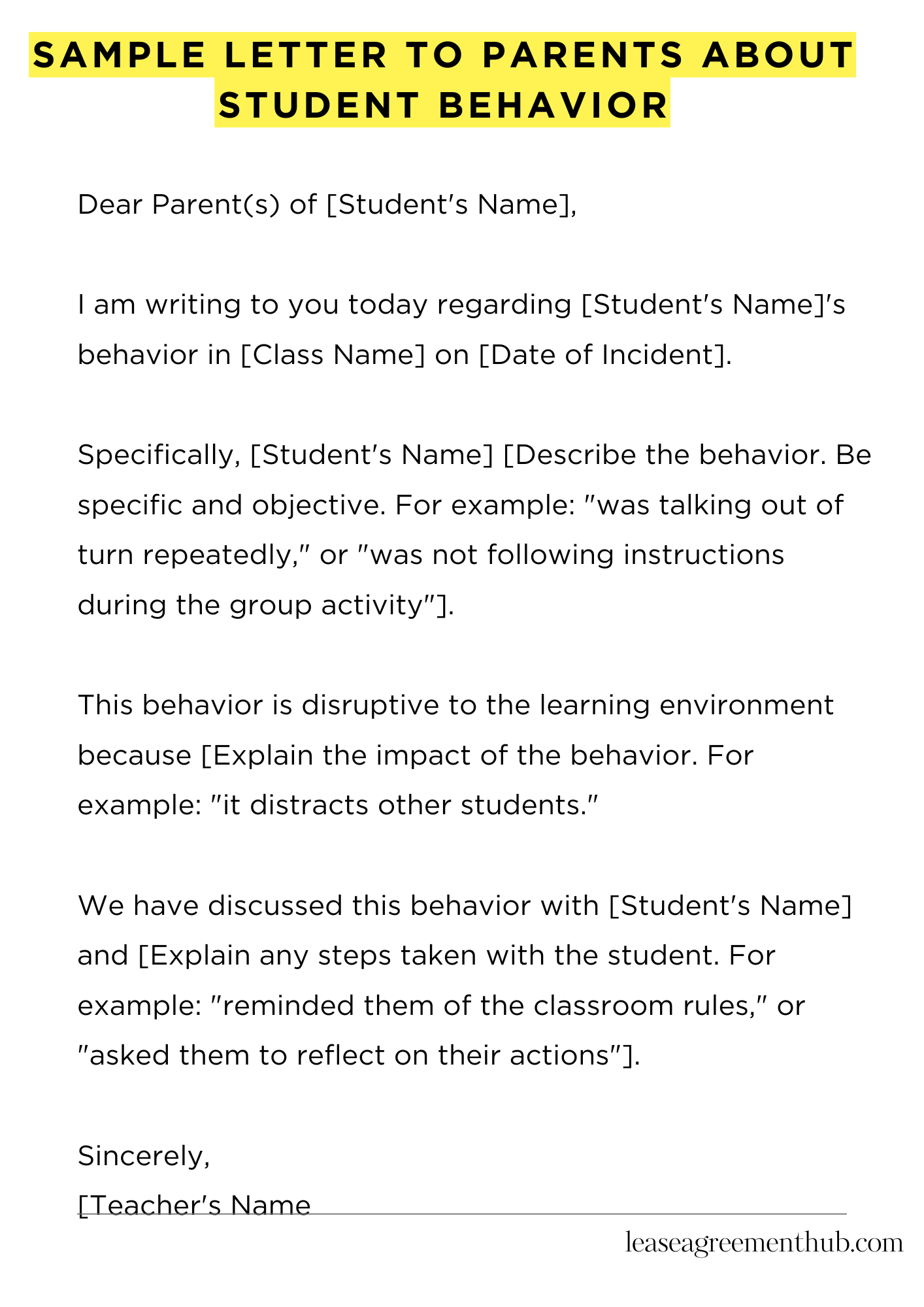A “Sample Letter To Parents About Student Behavior” is a pre-written template. It helps teachers communicate with parents. It’s used when a student’s behavior is concerning. This could be about academic issues or classroom disruptions.
Need to write a letter about a student’s behavior? Don’t worry, you’re not alone. Writing these letters can be tough. We’re here to help make it easier.
We’ll share some templates and examples. These samples will guide you. You can easily adapt them. They’ll fit your specific situation.
Sample Letter To Parents About Student Behavior
[Date]
Dear Parent(s) of [Student’s Name],
I am writing to you today regarding [Student’s Name]’s behavior in [Class Name] on [Date of Incident].
Specifically, [Student’s Name] [Describe the behavior. Be specific and objective. For example: “was talking out of turn repeatedly,” or “was not following instructions during the group activity”].
This behavior is disruptive to the learning environment because [Explain the impact of the behavior. For example: “it distracts other students,” or “it prevents [Student’s Name] from completing their work”].
We have discussed this behavior with [Student’s Name] and [Explain any steps taken with the student. For example: “reminded them of the classroom rules,” or “asked them to reflect on their actions”].
We believe it is important to address this issue promptly and collaboratively. We would appreciate it if you could speak with [Student’s Name] about the importance of [Desired behavior. For example: “respecting classroom rules,” or “participating appropriately in class”].
We are committed to helping [Student’s Name] succeed in our classroom. We believe that by working together, we can help them improve their behavior and reach their full potential.
Please feel free to contact me at [Phone Number] or [Email Address] to discuss this matter further.
Sincerely,
[Teacher’s Name]

How to Write Letter To Parents About Student Behavior
Subject Line: Clarity is Paramount
- Keep it succinct and direct. Avoid ambiguity.
- Instead of “Regarding [Student Name],” opt for “Concerning [Student Name]’s Behavior in Class.”
- A well-crafted subject line ensures the email won’t languish unread.
Salutation: Setting the Tone
- “Dear Mr. and Mrs. [Parent’s Last Name],” is generally a safe bet.
- If unsure of marital status or prefer a less formal approach, “Dear Parent(s) of [Student Name],” works well.
- If you have a rapport, “Dear [Parent’s First Name],” is acceptable, but tread cautiously.
Introduction: Laying the Groundwork
- Begin with a brief, benign statement about the student. Acknowledge any positive attributes.
- Segue into the reason for the communication. “I am writing to you today to express my concerns regarding [Student Name]’s recent behavior…”
- Avoid accusatory language upfront. Frame it as a collaborative endeavor.
Body Paragraph 1: Specifying the Transgressions
- Detail the specific instances of misbehavior. Be precise; avoid generalizations.
- Instead of “disruptive,” write “During the math lesson on October 26th, [Student Name] was talking out of turn and distracting other students.”
- Maintain an objective, non-judgmental tone. Focus on actions, not character.
Body Paragraph 2: Impact and Ramifications
- Explain how the behavior is affecting the student’s own learning or the learning environment for others.
- “This behavior impedes [Student Name]’s ability to focus on the lesson material and prevents other students from concentrating.”
- Elucidate any school policies that have been contravened.
Proposed Solutions and Parental Involvement: Charting a Course Forward
- Suggest actionable steps to rectify the situation. This could include a meeting, counseling, or a behavior contract.
- “I would like to schedule a meeting with you to discuss strategies for addressing this behavior. Please let me know what time works best.”
- Emphasize the importance of parental involvement in fostering positive behavioral changes.
Closing: A Cordial Farewell
- End on a positive, hopeful note. Reiterate your commitment to the student’s success.
- “I am confident that by working together, we can help [Student Name] reach their full potential.”
- Use a professional closing such as “Sincerely,” or “Best regards,” followed by your name and title.
Frequently Asked Questions: Sample Letter to Parents About Student Behavior
This section addresses common inquiries regarding sample letters to parents concerning student behavior. It aims to provide clear and concise answers for educators and administrators seeking guidance on this topic.
1. What should be included in a sample letter to parents about student behavior?
A sample letter should include the student’s name, date, a clear description of the behavior, its impact, relevant school policies, and contact information for communication.
2. How formal should the tone of the letter be?
The tone should be formal and professional, avoiding accusatory language and focusing on objective observations of the behavior.
3. Is it necessary to include potential consequences in the letter?
Yes, outlining potential consequences, if applicable, helps ensure transparency and reinforces the seriousness of the behavior.
4. Should positive aspects of the student’s behavior be mentioned?
Including positive aspects can provide context and demonstrate a balanced perspective, fostering a more constructive dialogue.
5. What is the best way to deliver the letter to the parents?
Delivering the letter via certified mail or scheduling a meeting ensures receipt and provides an opportunity for direct discussion.
Related: